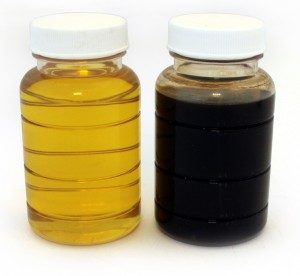Oil contamination causes approximately 80% of all oil system failures!
 This contamination takes the form of insoluble materials such as metals, dust particles, sand and rubber. The smallest particles, those below 2 µm, and better known as silt, resin or oxidation deposits are often responsible for defects.
This contamination takes the form of insoluble materials such as metals, dust particles, sand and rubber. The smallest particles, those below 2 µm, and better known as silt, resin or oxidation deposits are often responsible for defects.
Many of these contaminants influence equipment reliability and lifetime. Nearly 100% of all problems related to contamination of oil and other fluids can be prevented.
PARTICLES
Today’s machinery must be fast, accurate and economical.
Oil is increasingly stressed as machinery tolerances become finer, often below 3 microns. Since particles of this size can cause immediate breakdown, reducing their number to as few as possible is a priority.
Oil filtration is the most effective and economical way to remove smaller particles effectively. Research has shown that up to 6 times longer equipment lifetime – or even more – can be achieved through effective off-line oil filtration.
FREE WATER
Water in oil is an almost invisible contaminant with dramatic effects on system efficiency. Water can be seen in some oil samples since it collates at the bottom of the sample glass or reduces the oil’s translucency. Small volumes of water can only be detected by analysis.
Water reduces oil’s ability to lubricate, which leads to higher operating temperatures, resulting in oil degradation products such as generation of oxidation by-products, resin and varnish. Together with particles, oil degradation products are responsible for micro-pitting on component surfaces.
Another well-known effect of water in oil is corrosion. If water in oil is not removed effectively, equipment lifetime is quickly reduced.
DISSOLVED WATER
In some applications e.g. marine, steel and paper industries, ingress of water is a major problem. In order to avoid excessive amount of free water settling out in bearings and gears, special oils with the ability to hold water suspended, have been developed e.g. oil for paper machines.
Water can be dissolved in oil in two ways:
Suspended and tied up until the oil’s saturation point
(typically between 200 – 600 ppm water, depending on oil type)
Emulsions – colloidal suspended water in levels above the saturation point
For optimal protection of machine components, the water content should not exceed 30% of the saturation point. Emulsions of water/oil occur mainly due to shear forces in machinery e.g. in pumps, gears and valves.
The problems caused by emulsified water are similar to those of free water i.e. corrosion, cavitation, micro-pitting and oil degradation. Degraded oil only separates water poorly, because the oxidation products (acid, aldehydes, ketones) are polar and encapsulate water droplets, hindering merging of drops and separation by gravitation.
OIL DEGRADATION
Avoid Problems when Your Oil Ages
Oil degradation – such as oxidation products, resin, sludge and varnish – is a common problem in many industries. When oil is being used in a machine, it will degrade over a period of time, depending on the type of oil, the temperature, operational conditions and the environment.
Oil degradation can have negative effects on lubrication and hydraulic system, and may result in corrosion, sticking valves, lacquering and varnish on metal surfaces. These problems may result in serious consequences for the performance of the machinery, and may reduce the reliability of the machines.
Documented results clearly demonstrate that removing oil degradation products eliminates unplanned production stops dramatically, increases the reliability and lifetime of expensive components.
OXYGEN / AIR
Oxygen and air typically enter an oil system due to defect suction lines, insufficient de-aeration after assembly or inadequate tank design. In transformers, gas is a consequence of degraded cellulose in paper insulation.
The negative effects of oxygen and air in oil systems are either cavitation that leads to system break-down, or increased oil compressibility, which reduces operating precision. Both are critical in today’s industrial processes, where equipment reliability and lifetime are in constant focus. In transformers, degraded paper insulation can lead to transformer fires.
ACID
Acids are formed in the presence of moisture, heat and oxygen. Acids are also formed as a result of ageing oil. The Total Acid Number (TAN measured) indicates oil’s total acid content of oil, but not the strength of the acids.
Reducing the acidity of oil, for instance transformer oil or gas engine oil, reduces the ageing of the oil and the wear on equipment. In doing so, equipment reliability and lifetime are increased.
OIL IN WATER
Oil in water occurs typically in marine bilge systems and waste water from industrial processes. The discharge of oil in water is generally undesirable because it harms the environment, so regulations on contamination levels are increasingly strict.
In many industrial processes, detergents and high-pressure washing causes oil to mix with water. In marine bilge systems, oil is mixed with water and other materials in the bilge water tank.